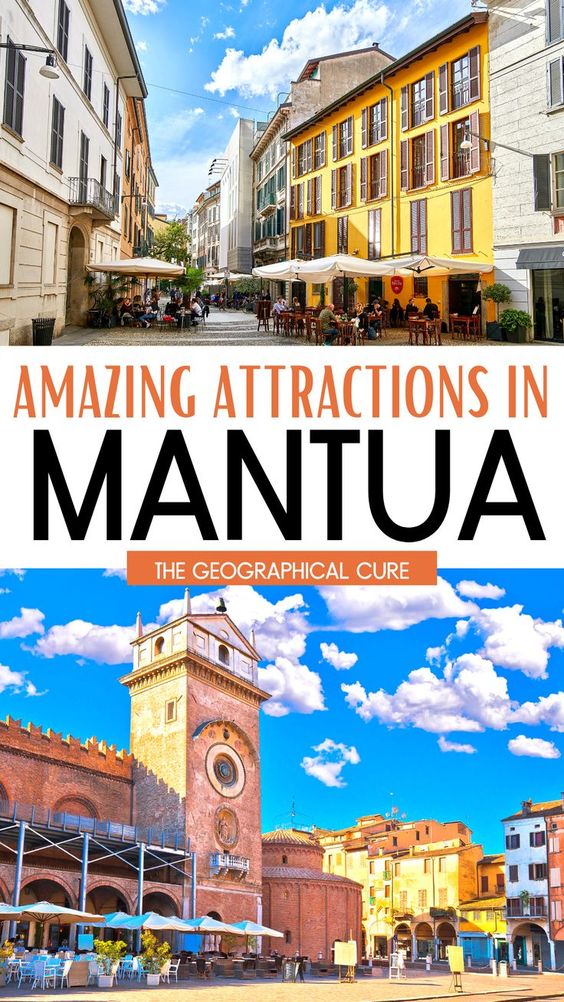Here’s my guide to visiting the lovely town of Mantua in northern Italy’s Lombardy region.
This Mantua guide covers the top attractions in art-filled Mantua. You’ll discover the must visit churches, opulent palaces, and historic landmarks.
Mantua is a small town with big art. It’s the perfect for art lovers and history buffs. Italy is usually overflowing with crowds. But in undiscovered Mantua, or Mantova, the world is still and quiet.
Given its beauty and rich heritage of Renaissance treasures, Mantua is surely one of Europe’s best kept secrets. It’s like a mini-Florence without the constant tourist siege.
Mantua is known locally as a “sleeping beauty” that hasn’t changed since the Middle Ages. Aldous Huxley called it “the most romantic city in the world.”
But Mantua may not be a hidden gem for long. In 2008, Mantua’s entire historic center became a designated UNESO site, just like Florence Italy and Bath England.
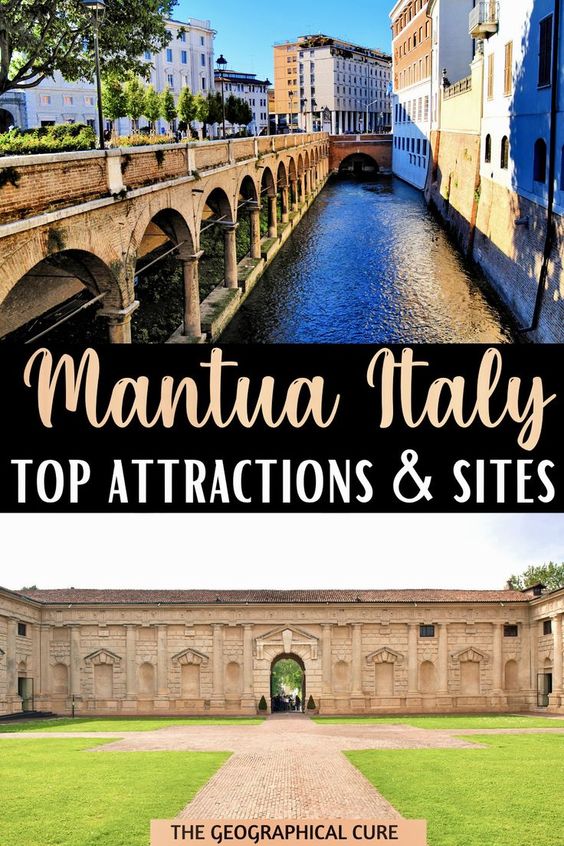
In 2016, the town was named the European Capital of Culture. In 2017, Mantua was listed as the European Capital of Gastronomy (think pumpkin ravioli and donkey stew).
Mantua is an easy day trip from Milan, Venice, Bologna, or Verona. It’s the perfect place to stop for a day or two on a road trip from Venice to Milan.
Mantua is steeped in history. The town was the birthplace of the poet Virgil.
In Shakespeare’s Romeo and Juliet, Romeo sought shelter in Mantua. The musician Verdi set his opera Rigoletto in Mantua. The composer Monteverdi premiered his opera L’Orfeo in the town.
Mantua is surrounded by three lakes, with a dramatic water-reflecting cityscape of spires, domes, and towers. The town’s compact center is the perfect place for strolling — with arcaded streets, cobbled lanes, pretty squares, and graceful buildings.
Meet the Gonzaga Family, Rulers of Mantua
What makes Mantua especially dreamy is its top attractions — the Renaissance architecture and stunning fresco cycles. They came courtesy of the aristocratic Gonzaga family who ruled Mantua (mostly benignly) for four centuries.
Originally a land owning gentry, the shrewd Gonzaga seized power in the 14th century. Over time, the Gonzaga received honorifics from the Holy Roman emperors that catapulted them from lords, to marquises, to dukes.
In the 17th century, the Gonzaga hit the jackpot when the family’s daughters married Holy Roman Emperors. Altogether, the Gonzaga numbered 12 cardinals, 14 bishops, and 1 saint.
Not only were the Gonzagas great warlords, they were also great art patrons. To give Mantua some real Renaissance cache, Ludovico III competed for the greatest artists and architects of the Renaissance era.
He succeeded in luring Leon Battista Alberti, Andrea Mantegna, and Giulio Romano (Raphael’s favorite pupil) to Mantua. These artists and architects transformed a provincial backwater into a cultural powerhouse, one of Italy’s greatest Renaissance courts.
One of the most influential Gonzaga members was Francesco II’s wife Isabella d’Este. Isabella was born to a sophisticated and elite noble family in Ferrara.
She received the same education as her brothers. Like the Renaissance men, she was multi-talented. She had a flair for fashion, politics, and music combined with an eye for exquisite art.
Isabella became one of the preeminent patrons of the Renaissance. She avidly collected and commissioned hundreds of artworks.
Leonardo da Vinci may have painted her portrait (the disputed painting is now in Milan), and there is an authenticated Leonardo drawing of her in the Louvre. Isabella was also depicted by the famed Venetian artist Titian.
Top Attractions in Mantua
Here’s my list of all the top attractions and best things to do and see in Mantua. Everything is within easy walking distance. If pressed for time, you can cover Mantua’s splendid sites in a single day.
But, it’s preferable to allot two days to really absorb all of Mantua’s magnificent attractions and landmarks. That way, you’ll avoid sensory overload.
Plus, you really want to have ample time to see both the Ducal Palace and Te Palace, especially since Te Palace is slightly off center.
1. Piazzas in Mantua’s Historic Center
Mantua has four interlinking main squares: Piazza Sordello, Piazza Erbe, Piazza Mantegna, and Piazza Broletto. The squares are all flanked with magnificent Renaissance buildings. Around them are an intriguing maze of streets and cobbled lanes.
The Piazza Mantegna is dominated by the facade of Alberti’s great unfinished Church of Sant’Andrea. Housing the weekly market, the Piazza Erbe has a fetching long series of porticos, a tall clock tower, and is the site of the 11th century Rotunda di San Lorenzo.
The incredibly beautiful Piazza Sordello is Mantua’s oldest square. The square is home to the Ducal Palace and the Duomo, the Cathedral of St. Peter. From the bridge across the water, you’ll have a beautiful view of Mantua.
You may want to book a 2 hour guided walking tour for an overview. You can also book a 3.5 hour guided private tour of Mantua’s top attractions.
2. Palazzo Ducal
The Ducal Palace, or Palazzo Ducale, is Mantua’s top attraction. It’s the second largest residential building in Europe, after the Vatican. The Gonzaga’s palace is truly enormous.
The Ducal Palace is essentially a private city interconnected by courtyards, corridors, and staircases — nicknamed the “Gonzaga Realm.” Because it was constantly expanded, it’s a bit of a hodgepodge architecturally, with late medieval, Renaissance, and 17th century styles.
There are four main parts: (1) the Old Court, with the medieval buildings overlooking Piazza Sordello; (2) the New Court, designed by Giulio Romano and built in the 15th and 16th century; (3) a Renaissance style church; (4) and the medieval fortress-castle of San Giorgio, which Ludovico I converted into a swanky private residence.
Within the medieval facade of this palace-fortress lies the history of the Gonzaga family. You’ll find their apartments and what’s left of the fabulous treasures they collected. In total, there’s a maze of 600 ornate gilded, frescoed, and marbled rooms, topped with a Hall of Mirrors. I’ll cover some of my favorites.
The Pisanello Room in the Old Court has incredible frescos by Pisanello. They depict a medieval Arthurian-style tournament. The frescos were badly damaged over time, but restored in 1960.
There are also some tapestries based on Raphael cartoons, copies of ones in Rome’s Vatican Museums.
READ: Guide To The Paintings Of Raphael
The Zodiac Room was the bedroom of Guglielmo Gonzaga. It has a rather psychedelic astronomical fresco painted by Lorenzo Costa in 1579. It depicts a pregnant Diana’s chariot being pulled by a pack of dogs among the constellations. The room also served as Napoleon’s bedroom during the Napoleonic Wars.
The apartment-studio of Isabella d’Este is magnificent. It’s a special private study, sometimes called the studiolo or camerini, in the Old Court.
In three interconnected rooms, the venerable art collector amassed works by Michelangelo, Perugino, Correggio, and Mantegna. They were sold to Charles I of England when the Gonzagas hit upon hard times.
Click here for information on opening hours and tickets for the Ducal Palace. There is plenty of information in both English and Italian onsite. You will have to pay a bit extra to see the famous Camera degli Sposi, which I discuss below.
You may want to book a guided tour of the Ducal Palace. You can book this 2 hour tour of the palace or a 3 hour walking tour that incudes the palace.
3. Mantegna’s Masterpiece: Mantegna’s Camera degli Sposi
The absolute highlight of the Ducal Palace is the Camera degli Sposi, a Renaissance masterpiece painted by Mantua’s court painter, Andrea Mantegna. It’s also known as the Camera Picta (picture room) and the Bridal Chamber (for unknown reasons).
One of Ludovico III Gonzaga’s most important conquests was to lure Mantegna, an already well known artist, from Padua. He was promised artistic freedom and a hefty salary as a court painter. The frescoed room that Mantegna created in the Ducal Palace is considered one of the world’s prettiest rooms.
READ: Guide To the Scrovegni Chapel in Padua
The Camera is housed in the northern tower of the Castel San Giorgio. It’s a magical room with illusionistic paintings. The Camera is a hugely influential masterpiece from the Early Renaissance, considered the first trompe l’oeil in the entire history of painting.
Mantegna effectively transformed the small interior room into an elegant open air pavilion. It depicts scenes from the life of the Gonzaga, reinforcing their power and importance.
The Camera’s most famous scene is above the fireplace on the north wall. It’s a long horizontal scene. One the left side you see a man in a pink house coat, with the family dog at his feet. That, in fact, is Ludovico III. It’s a snapshot of daily life, when the family is at their ease.
The other real highlight is the celebrated false oculus, or eye, in the ceiling (shown above). It’s an illusionistic opening in the center of the ceiling, which seems to open to a blue sky. Mantegna painted the oculus to appear like marble surrounded by a garland.
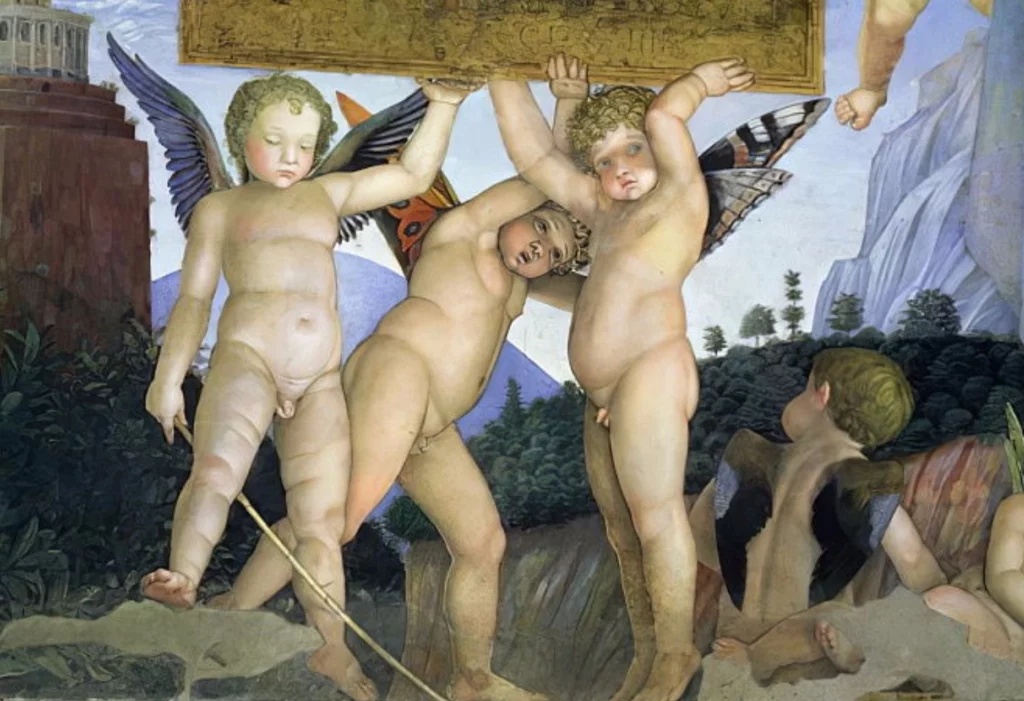
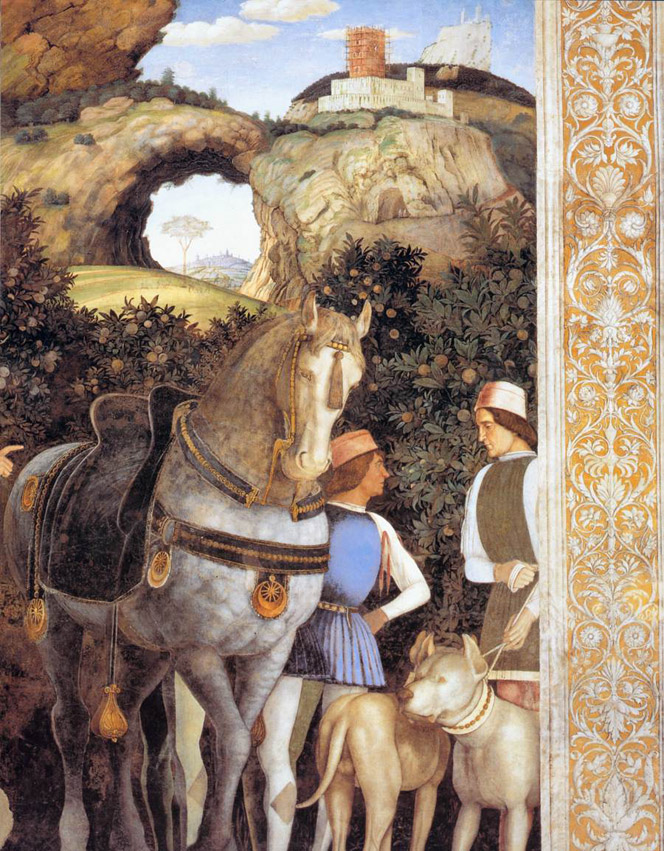
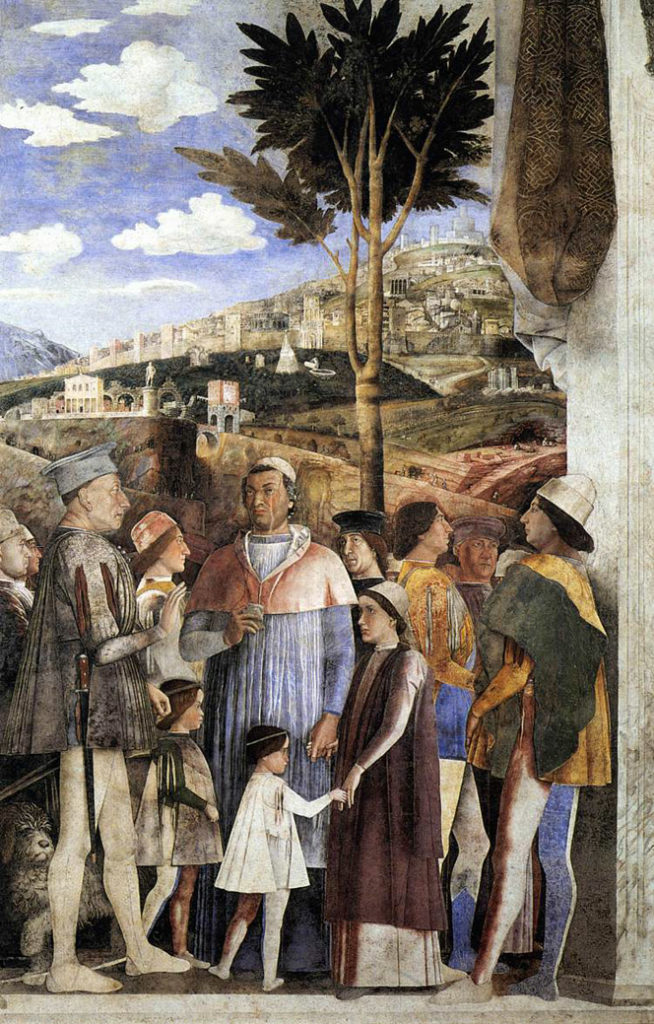
The oculus was likely intended to exalt the Gonzaga family by suggesting the heavenly throng above were interested in their daily lives. There’s a tiny self portrait of Mantegna, hidden in the elaborate foliage on a painted pillar.
You’ve got to be organized to see the Camera. Admission is limited, so you have to reserve a time slot for visiting when you buy your ticket to the Palazzo Ducal.
Here’s my complete guide to visiting the Camera degli Sposi.
4. Castel San Giorgio
Built between 1390 and 1406, the Castle San Giorgio began life as a medieval fortress. Ludovico I converted it into an opulent residence in the 15th century.
Over the centuries, the castle was absorbed into the Ducal Palace, and can be visited on a palace visit.
The castle has four square corner turrets and a massive moat with draw bridges. Inside, is the beautiful spiral Staircase of the Horses and the Sala degli Affreschi, which once served as the Gonzaga library.
As I mentioned above, the castle also houses Mantegna’s Camera degli Sposi. Click here to book a private guided tour of St. George’s Castle and the Ducal Palace.
5. Palazzo Te | Te Palace
Te Palace is another must visit wonder and top attraction in Mantua. The extraordinary Palazzo was built on a small island connected to the mainland via a bridge.
It’s a low slung geometric structure built around a square courtyard, giving the illusion of being a massive complex.
The palace was designed and decorated by the talented artist-architect Romano. You can’t leave Mantua without seeing this magnificent tour de force of a building. From Mantua’s center, take the Via Principe Amedeo and walk for approximately 20 minutes.
Te Palace is all about love. Or lust. It was the bling-y summer palace of the Gonzaga family.
Te Palace was built for the pleasure loving son of Isabella d’Este, Frederico II. He used it as an escape pad — to get away from his wife, his mother, and the restricted court life of the Ducal Palace.
Frederico fancied himself a Dionysis type. In Te Palace, he let his fancy run wild, blinging up the palace with sybaritic tongue-in-cheek frescos. Every detail was designed to delight the viewer.
From the courtyard, you enter into the Loggia of the Muse. This is a hallway dedicated to the muses — the goddesses of art, literature, and science.
They’re frescoed in the bas reliefs of the vaults and in the lunettes. One muse represents Mantua, lying near a fountain topped with a crown of laurels referring to the poet Virgil.
The Hall of the Eagles is Frederico’s bedroom. The ceiling hangs like a canopy. Lunette curves encrusted with seashells frame paintings of classical stories.
There are three absolutely must see rooms in Te Palace. They’re filled with lavish, almost mind-blowing, Mannerist frescos executed by Romano in 1525-35.

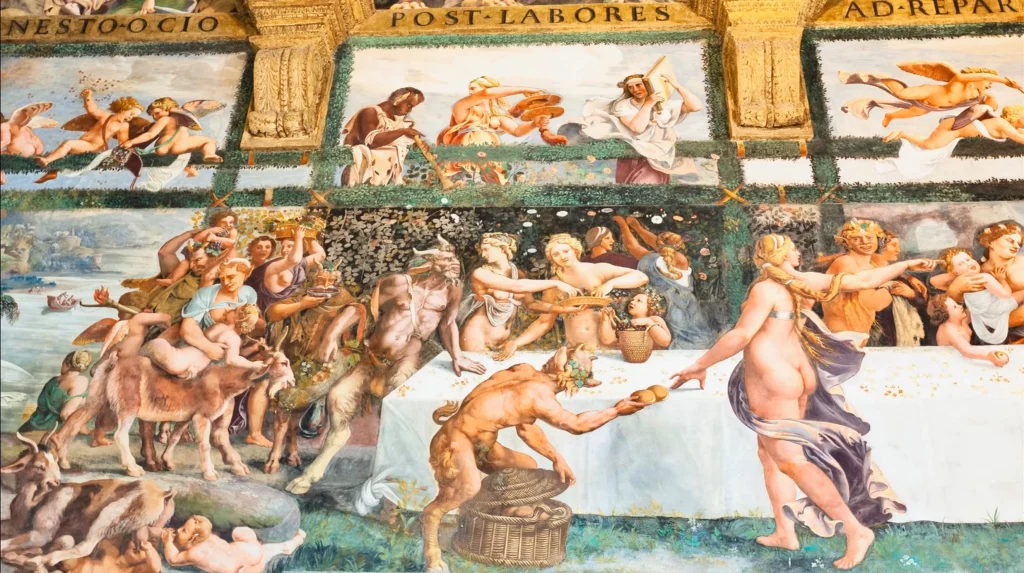
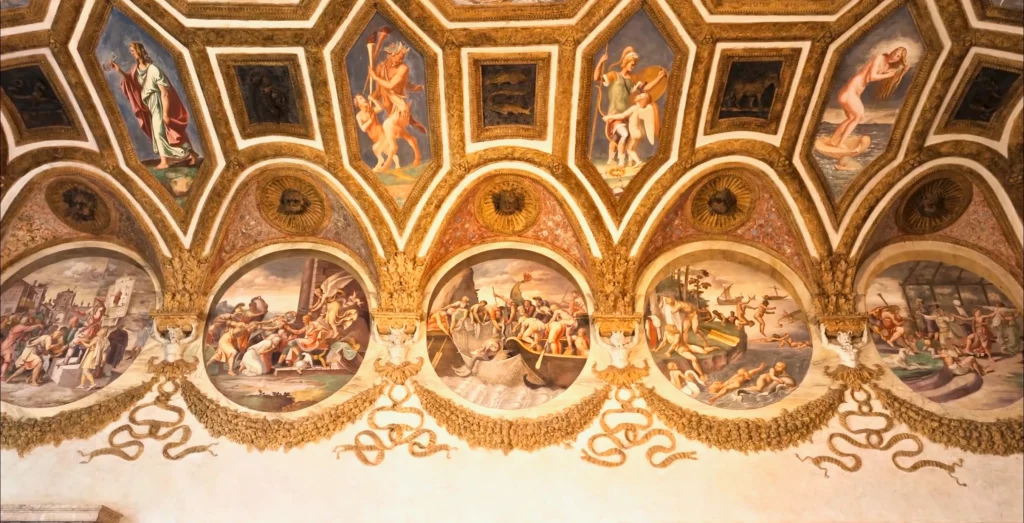
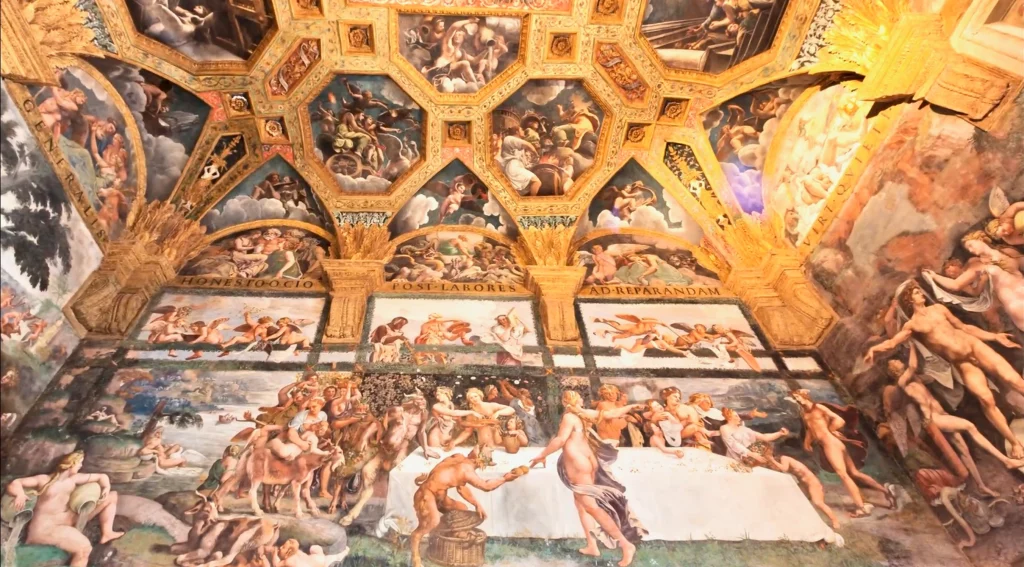
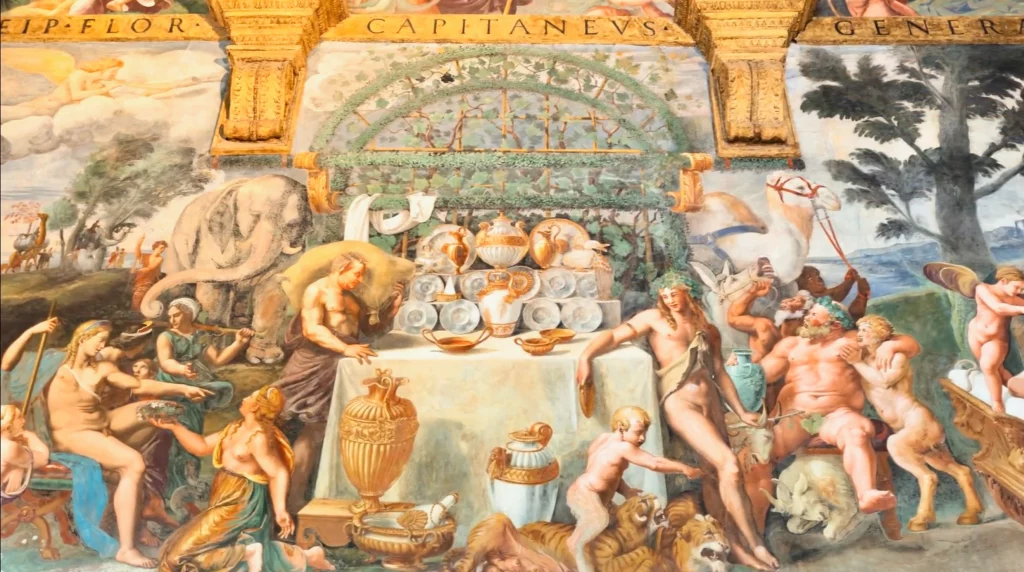
The Sala dei Cavalli, or Hall of the Horses, is the banquet hall where the Gonzaga were surrounded by paintings of their favorite prize-winning horses. Gray and brown horses stand in profile, looking almost 3D. They’re almost life size, set against faux marble walls and landscapes.
The Sala of Psych is the most opulent room, filled with erotic paintings bordering on debauchery. Not coincidentally, the fleshy frescos were close to Frederico’s bedroom, perhaps mirroring the seduction inside.
The frescos depict Cupid and Psyche and the theme of their forbidden love. The mythological pair are a stand in for the forbidden love of Frederico and his mistress (also named) Isabella. They show man’s struggle to rise above human weakness and be transformed into a transcendent deity.
The figures and gods cavort and flirt with abandon. There’s a racy scene of Jupiter about to ravish Olympia, a wedding scene, and nude women being led away for a romp.
The staggering Salle dei Giganti, Hall of the Giants, is Palazzo Te’s grand finale. The famous grotto-like hall is decorated with colossal scale figures. It’s almost an alternative reality.
In this fresco cycle, Romano portrays a disaster story from Ovid’s Metamorphosis. The gods take revenge on Polyphemus and his cadre of ugly comic-book faced giants.
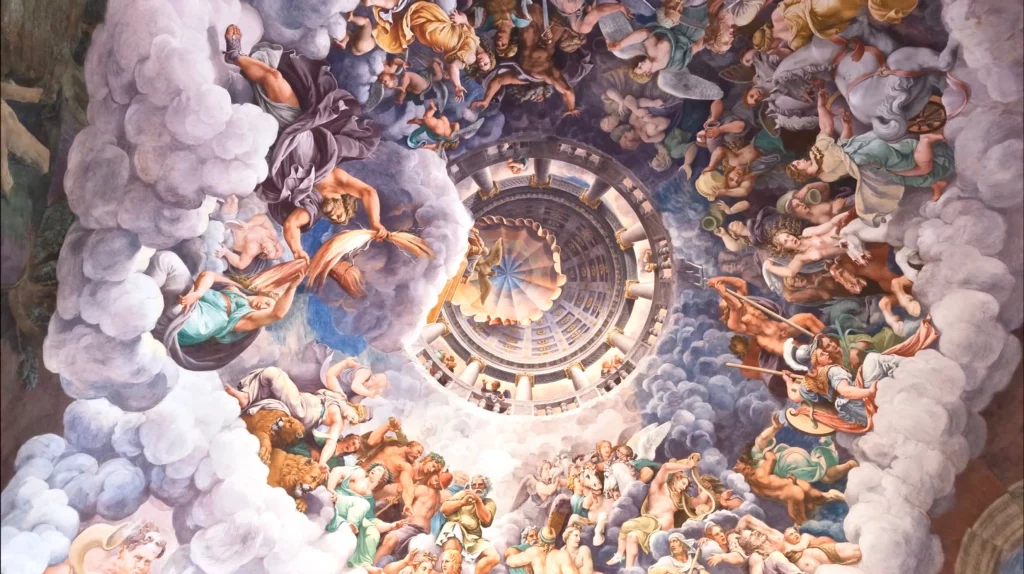
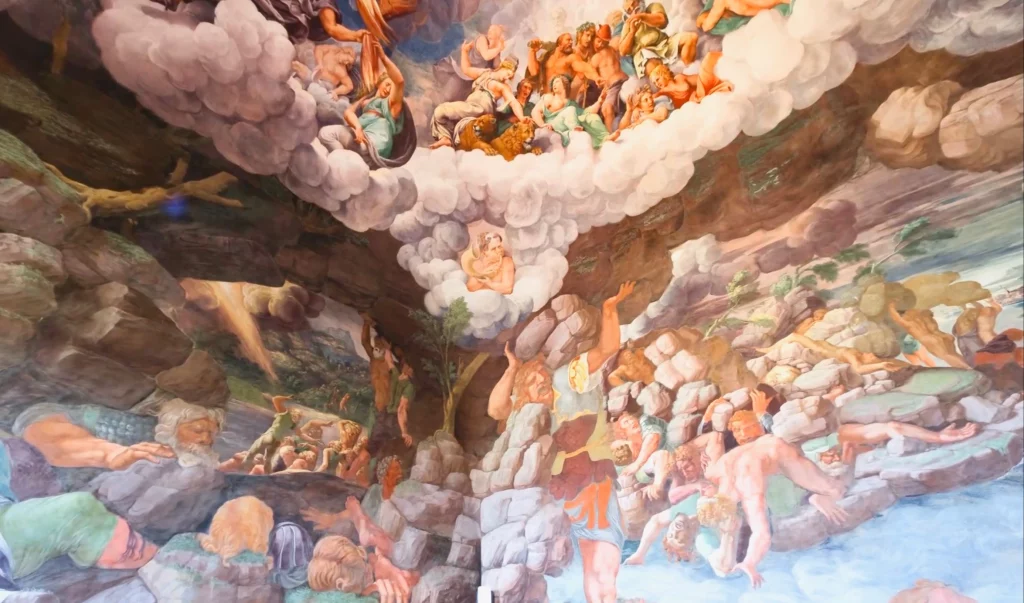
Jupiter and other gods destroy the giants, who committed the heinous and feckless sin of daring to climb Mount Olympus.
In what seems like a storm, the gods fling down pillars and lightening bolts. Buildings topple. The giants cringe and scream at their terrible fate. The frescos are pulsating, powerful, and rhythmic.
In person, the Te Palace frescos are so powerful that they’re akin to visiting the Sistine Chapel in the Vatican Museums.
Click here to book a 1.5 hour guided tour of the magnificent Te Palace.
6. Basilica di Sant’Andrea | Basilica of Saint Andrew
Ludovico III commissioned the great Renaissance architect Alberti to build the city’s great 15th century Basilica of Sant’Andrea. The church is a top attraction in Mantua, dating from the same period as Mantegna’s Camera deli Sposi. The basilica is a veritable milestone in the history of architecture.
Sant’Andrea is famed for allegedly housing a holy relic of Christ’s blood, brought to Mantua by St. Longinus, the Roman centurion who pierced Christ’s side. That relic is removed from the crypt and displayed, with celebratory panache, once a year on Good Friday.
The basilica is named Saint Andrew because he helped the bumbling Mantuans. When Mantua was under attack, the citizens feared the relic would be stolen and hid it away.
But they hid it so secretly that they forgot the location. Saint Andrew appeared in a vision and led them to the relic, thereby receiving the church dedication.
Ludovico wanted Alberti to design and build a classically-inspired building that would be worthy of the important relic. The existing medieval structure just wasn’t good enough. Alberti obliged, designing one of the most beautiful pilgrimage churches in Italy.
The church was built on an ancient Benedictine monastery. Evidence of that is the Gothic-looking bell tower next to the basilica. It’s a tight fit. Alberti had to really squeeze the church in.
The magnificent triumphal-arch facade is the most important part of the church. It represents a radical return to classicism. The facade is divided vertically into three bays, defined by four colossal pilaster bands.
The pilasters don’t serve an architectural function; they’re just decorative. The pilasters are topped with capitals decorated with acanthus leaves. Michelangelo would copy this pilaster motif in his work on Capitoline Hill in Rome and in St. Peter’s Basilica.
READ: Guide To Rome’s Capitoline Museums
The central bay is the largest. Two fluted pilasters support a semi-circular coffered barrel vault.
The vault gives depth to the facade, which meant the facade has a dual function as a facade and a vestibule-porch. This gives the church a transition space between the secular and spiritual world.
The two flanking bays are narrower. They have striking surmounted architectural elements — door, niche, window. A triangular pediment sits on top.
The weird looking cupola-arch above the pediment isn’t an Alberti element. It was designed by Filippo Juvarra in the late 18th century, to shade an internal oculus. Most experts think it’s cringingly unharmonious with Alberti’s facade.
In the interior, there’s a single large nave with a massive barrel vault. Alberti’s inspiration for the nave was the remains of the Basilica of Maxentius and Constantine, an archaeological site in Rome. On the sides are massive walls with recesses or niches for chapels.
The first chapel on the left is the resting place of Mantegna, designed by the artist himself.
There are also pale frescos that Mantegna designed, which were executed by (among others) his student Correggio.
7. St. Peter Cathedral
In Piazza Sordello, the Duomo of San Pietro dates back 900 years. It has an 18th century facade. It’s a pastiche of 15th century Gothic red brick blanketed by an 18th century white marble facade.
Inside, the interior resembles a classical temple. It was remodeled after a fire based on designs left behind by the brilliant Romano.
On either side of St. Peter’s altar are frescos commemorating a meeting held at Mantua with various popes. The Gonzaga were skillful diplomats and successful in juggling the competing interests of both their overlords in Rome (the popes) and those in Germany (the Holy Roman Emperors).
8. Teatro Bibiena
The Teatro Bibiena is also known as the Teatro Scientific. It was inaugurated in 1769 and is known for its fabulous accoustics.
The theater was designed and built by Bibiena in 1769. It’s home to the Mantua Chamber Orchestra and a main venue of the annual Mantua Chamber Music festival. Perhaps the theater is most famous for hosting the debut concert of a 13 year old Mozart.
The theater itself is a charmer. It’s one of the most perfect Barque theaters in Europe, built entirely out of wood. Velvet, gilding, and stucco decorate the interior. Elegant balconies surround the stage. Statues of Mantua’s historic greats adorn the theater.
9. Rotunda of San Lorenzo
The Romanesque Rotunda of San Lorenzo is a small architectural gem, built in the 11th century by the Canossa family. It’s an incredibly ancient church and must visit attraction in Mantua.
An unusual circular building, the rotunda is an idealized version of the Holy Sepulchre in Jerusalem. Its red brick walls still bear the remains of frescos once painted there.
For centuries, the rotunda was buried under the facades of other structures. It was only rediscovered in 1907. In 1926, the dome was reconstructed. The church is once again consecrated and open to the public with free entry. Inside are remains of Byzantine and 15th century frescos.
10. Church of San Sebastian
The Church of San Sebastian was another combo effort of Alberti and Ludovico Gonzaga. Construction of the unique building began in 1460, some time before Alberti’s death.
The rest of the project was overseen by Luca Fancelli. It was conceived either as a mausoleum for the Gonzaga or a votive church.
The church is configured in a Greek cross. Its facade and vestibule opening at the sides are reminiscent of Sant’Andrea. The church is divided into two floors.
It’s a simple plan, with perfect mathematical proportions. A tympanum surmounts a square facade with five portals. A Syrian arch stands above the tympanum. Initially a symbol of dynastic power, the church is now a place of worship.
11. Palazzo San Sebastiano
The Palace of San Sebastiano was built by Francesco II Gonzaga in the 16th century. The palace once held one of Mantegna’s most famous fresco cycles, The Triumphs of Caesar. The frescos were sold and are now housed in London’s Hampton Court Palace.
When the palace was renovated in 20th century, grotesque frescos were discovered. Grotesques are the unique frescos that were popularized after Renaissance artists discovered Nero’s Golden House, Domus Aurea, in Rome.
READ: Guide to Domus Aurea
Since 2015, San Sebastiano has housed the Museum of the City. There, you’ll find works of art owned by the municipality and associated with Mantua’s various historic periods, from its origins to the 18th century.
12. Casa del Mantegna
500 years old, Casa del Mantegna is the stone house that Mantegna designed for himself. It’s a spectacular Renaissance home, two stories of refined geometry set in brick and stone.
The casa is unique in that, while palaces were being patterned after classical architecture, this was the first private residence to incorporate those elements.
From the outside, the house is almost bland. But, once inside, you step into a vast circular courtyard. The external cube contains a circular cylindrical atrium open to the sky, reminiscent of a Roman amphitheater and an allusion to his painted oculus in the Camera degli Sposi.
A tall arched door sits in the center of each curved side. The atrium walls are embellished with acanthus leaves. Long ago, they were covered in frescos and murals.
The inscription “AB OLYMPO,” appears on a lintel of a door in the circular courtyard. With its reference to Mount Olympus, Mantegna makes a connection between the art of men and the realm of the gods. It reflects the artist’s pride in his work, a kind of self-portrait.
There’s a grand first floor living room, with light from 5 windows. A faded painted frieze runs along the top. In his bedroom, Mantegna slept under a fresco depicting the Gonzaga symbol of the rising sun. You can see remnants today in azure and yellow colors.
Mantegna only lived in the house for 5 years. Beset by financial woes, he was forced to sell his home to a Francesco II in exchange for another small house.
Nowadays, Casa Mantegna is a center for contemporary art, hosting temporary exhibitions.
13. House of Giulio Romano
In 1531, as an established artist, Romano bought property for his house for 350 ducats. In building his own palazzo-home, he renovated two adjoining buildings. Redeveloping a model used by Bramante in Rome, Romano adopted a Tuscan archivolted order.
The facade is made of plaster and studio with a rusticated terra-cotta finish, as was the fashion. The second floor has a long array of windows topped by arches. In a niche, there’s a statue of Mercury.
The interior has frescos by Romano in the main hallway. The walls have Doric pilasters and panels decorated with statues and bas reliefs. The house is now privately owned.
You can see it as you’re walking south to Palazzo Te. It’s just a short jog off Via Poma.
Tips For Visiting Mantua
Here are some must know tips to help you enjoy all the attractions in Mantua.
1. How To Get To Mantua
Here’s how you can get to Mantua to see all it’s wonderful treasures and attractions.
By Plane:
The nearest airport is in Villafranca, Verona, about 20 miles from Mantua. International flights come from Amsterdam, London, Bruxelles, Edinburgh, Bucarest and others. Other close airports are “Gabriele D’annunzio” in Montichiari, Brescia, and “Giuseppe Verdi” in Parma, both are 37 miles from Mantua.
By Car
You can drive or take the train to Mantua. Here are the estimated driving distances from nearby cities to Mantua:
Bologna to Mantua: 1:20 Verona to Mantua: 40 minutes Venice to Mantua: 1:40 Milan to Mantua: 2 hours
By Train
Here’s the time by train:
- Milan to Mantua: 2 hours
- Bologna to Mantua: 1:45, with a change in Modena
- Verona to Mantua: 45 minutes
- Venezia Santa Lucia to Mantua: 2:30
The historic center of Mantua is a 10-15 minute walk from the train station in Piazza Don Leoni. You can also can take a taxi or the local bus. Mantua’s tourist office is located in the Piazza Mantega.
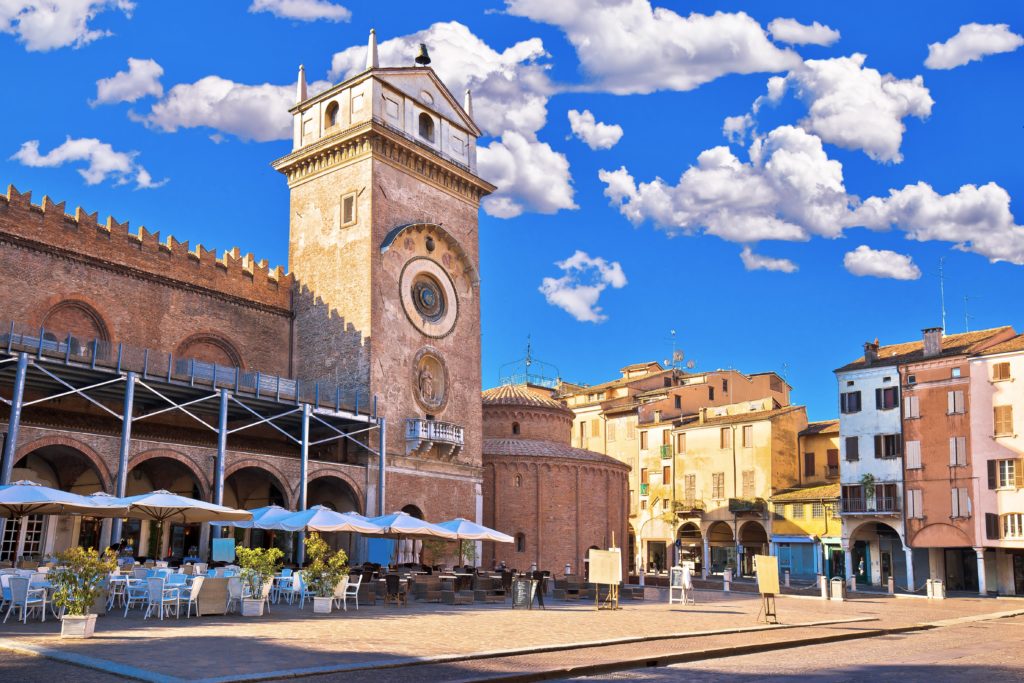
2. What To Eat In Mantua
Mantua has a delicious and distinctive cuisine. The city’s specialties are risottos, pastas stuffed with pumpkin, and filet of pike or sturgeon.
Restaurants to try include Il Cigno – Trattoria dei Martini, Carlo Govi Ristorante Mantova, Trattoria Al Portichetto or Osteria dell’Oca.
3. Where To Stay In Mantua
You have plenty of good hotel options in Mantua. You can consider:
- Hotel Casa Poli (elegant and stylish modern hotel)
- Grand Hotel San Lorenzo (lovely hotel near the Rotunda)
- Rechigi Hotel (gorgeous adults only hotel)
- Antica Dimora (housed in a restored 17th century building)
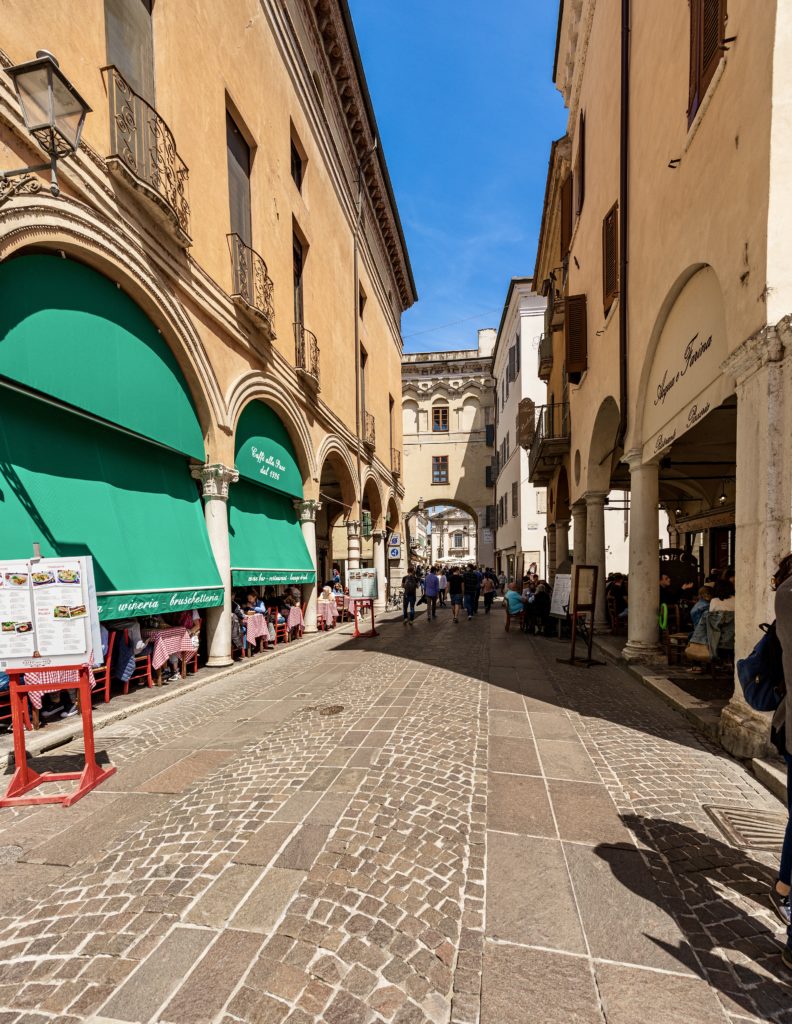
4. How To Get Around Mantua
Everything in Mantua can be reached within a few minutes on foot. You can also take a 3 hour guided Segway tour.
I hope you’ve enjoyed my guide to the top attractions in Mantua. You may enjoy these other Italy travel guides and resources:
- Historic Landmarks in Italy
- Most Beautiful Towns in Italy
- Best Art in Italy
- 10 Day Itinerary for Italy
- 10 Day Itinerary for Tuscany
- 3 Day Itinerary for Rome
- 3 Day Itinerary for Florence
- 2 Day Itinerary for Venice
- 24 Hours in Milan
- 24 Hours in Siena
If you’d like to see the top must visit attractions in Mantua, pin it for later.

